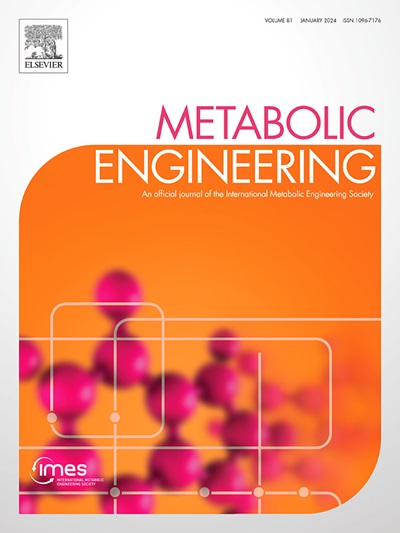Engineering phenylpyruvate decarboxylase for controlled biosynthesis of aromatic amino acid derivatives
IF 6.8
1区 生物学
Q1 BIOTECHNOLOGY & APPLIED MICROBIOLOGY
引用次数: 0
Abstract
The biosynthetic pathway of aromatic amino acids (AAAs) and its branches are crucial for producing bioactive compounds. ARO10, a phenylpyruvate decarboxylase in yeast, catalyzes the decarboxylation of 2-keto acids to aldehydes, playing a key role in AAA-derivative biosynthesis in yeast. However, its broad substrate specificity hinders efficient target synthesis. Here, we engineered ARO10 to create three mutants (I335E, A628F/H339I/I335M, H339C/I335T/A628Q) with specificity for 4-hydroxyphenylpyruvic acid (4-HPP), phenylpyruvic acid (PPA), and indole-3-pyruvic acid (I3P) through a “Design-Build-Test-Learn” (DBTL) framework. Mechanisms were explored via enzyme kinetics and molecular dynamics. These mutants enabled high-yield production of AAA-derivatives in yeast strains: 11.08 g/L tyrosol, 2.77 g/L 2-phenylethanol, and 1.21 g/L tryptophol in 5 L fed-batch bioreactor. These are the highest reported de novo titers to date in yeast. This work highlights the potential for engineering promiscuous enzymes to enhance sustainable biosynthesis of AAA-derivatives and alkaloids.

芳香族氨基酸衍生物控制生物合成的工程苯丙酮酸脱羧酶。
芳香族氨基酸及其分支的生物合成途径是产生生物活性化合物的重要途径。酵母中的苯丙酮酸脱羧酶ARO10可催化2-酮酸脱羧成醛,在酵母的aaa衍生物生物合成中起关键作用。然而,其广泛的底物特异性阻碍了有效的靶标合成。在这里,我们通过“设计-构建-测试-学习”(DBTL)框架,对ARO10进行改造,产生了三个突变体(I335E, A628F/H339I/I335M, H339C/I335T/A628Q),它们对4-羟基苯基丙酮酸(4-HPP),苯基丙酮酸(PPA)和吲哚-3-丙酮酸(I3P)具有特异性。通过酶动力学和分子动力学对其机理进行了探讨。这些突变体能够在酵母菌株中高产地生产aaa衍生物:在5l补料间歇式生物反应器中,11.08 g/L酪醇、2.77 g/L 2-苯乙醇和1.21 g/L色氨酸。这是迄今为止在酵母中报道的最高的新生滴度。这项工作强调了工程混交酶的潜力,以提高可持续的生物合成aaa衍生物和生物碱。
本文章由计算机程序翻译,如有差异,请以英文原文为准。
求助全文
约1分钟内获得全文
求助全文
来源期刊

Metabolic engineering
工程技术-生物工程与应用微生物
CiteScore
15.60
自引率
6.00%
发文量
140
审稿时长
44 days
期刊介绍:
Metabolic Engineering (MBE) is a journal that focuses on publishing original research papers on the directed modulation of metabolic pathways for metabolite overproduction or the enhancement of cellular properties. It welcomes papers that describe the engineering of native pathways and the synthesis of heterologous pathways to convert microorganisms into microbial cell factories. The journal covers experimental, computational, and modeling approaches for understanding metabolic pathways and manipulating them through genetic, media, or environmental means. Effective exploration of metabolic pathways necessitates the use of molecular biology and biochemistry methods, as well as engineering techniques for modeling and data analysis. MBE serves as a platform for interdisciplinary research in fields such as biochemistry, molecular biology, applied microbiology, cellular physiology, cellular nutrition in health and disease, and biochemical engineering. The journal publishes various types of papers, including original research papers and review papers. It is indexed and abstracted in databases such as Scopus, Embase, EMBiology, Current Contents - Life Sciences and Clinical Medicine, Science Citation Index, PubMed/Medline, CAS and Biotechnology Citation Index.
 求助内容:
求助内容: 应助结果提醒方式:
应助结果提醒方式:


